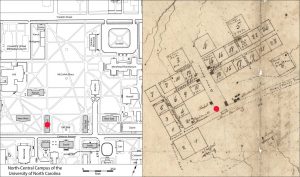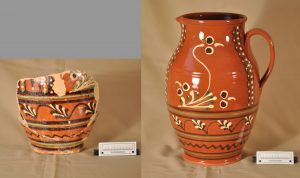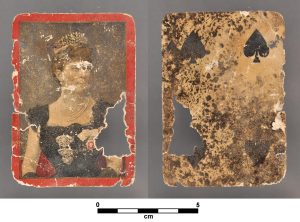Discoveries Beneath Old West

In 1991, just prior to the University’s bicentennial celebration, extensive repairs were made to two of its oldest buildings—Old East and Old West—situated along Cameron Avenue at the center of campus. Old West was built in 1822 and expanded in 1848, but it had not been substantially renovated since 1923. As part of the repairs made in 1991, the interior walls were stripped and re-plastered, and the wooden first floor was removed and replaced. No formal archaeological investigation was undertaken during this project; however, the crawlspace was examined by university archaeologists once the first floor had been removed, and construction crews reported several artifacts that they discovered during the course of their work.

Many of these artifacts are associated with the daily lives of the students who lived here during the building’s early years. They were discovered lying on the ground beneath the floor and behind the plaster walls, and the construction workers who found them donated their finds to the university. The artifacts include a playing card from the late nineteenth century that was tucked behind a chimney, a shoe dye bottle, a glass flask, a wine bottle neck, glass tumbler fragments, buttons, a horseshoe, fragments of animal bone, an embossed brass curtain tie back, and a several-thousand-year-old American Indian spear point. The spear point may have been lost by an ancient hunter at this spot, or it might have been picked up elsewhere by a student living in Old West.

Perhaps the most interesting artifact was the fragmented base of a slip-decorated earthenware pitcher made by a local potter during the early nineteenth century. As part of the bicentennial celebration in 1993, UNC’s College of Arts and Sciences commissioned North Carolina potter Hal Pugh to create a series of replicas based on this lead-glazed redware pitcher fragment found beneath Old West. The pitcher fragment and replica, as well as the playing card, are shown at right.
Contributor
R. P. Stephen Davis, Jr. (Research Laboratories of Archaeology, University of North Carolina, Chapel Hill)

*Image courtesy of the North Carolina Collection, University of North Carolina, Chapel Hill.
**Images courtesy of the Research Laboratories of Archaeology, University of North Carolina, Chapel Hill.
Source
Davis, R. P. Stephen, Jr.
2015 • The Hidden Campus: Archaeological Glimpses of UNC in the Nineteenth Century. Gladys Hall Coates University History Lecture, Wilson Library, University of North Carolina, Chapel Hill, April 14, 2015.
